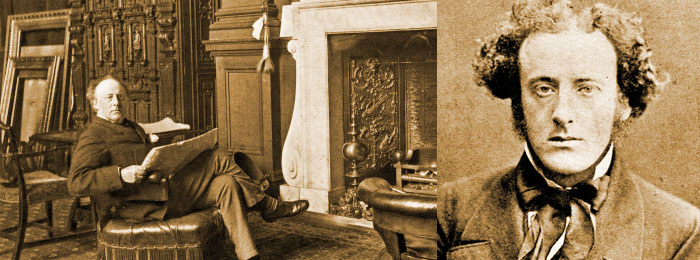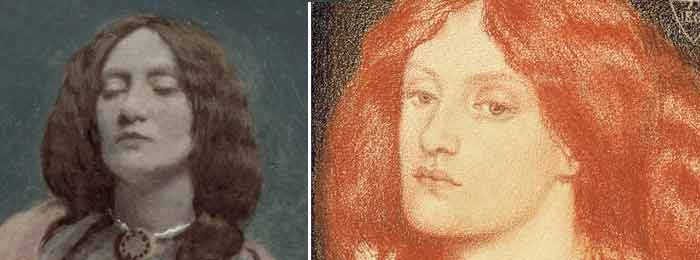On 8 Aug, 2015 With
Sir John Everett Millais was an English painter and illustrator and one of the founders of the Pre-Raphaelite Brotherhood. Millais’ Christ In The House Of His Parents was highly controversial because of its realistic portrayal of a working class Holy Family labouring in a messy carpentry workshop. All early works were painted with great attention to detail, often concentrating on the beauty and complexity of the natural world. In paintings such as Ophelia Millais created dense and elaborate pictorial surfaces based on the integration of naturalistic elements. This approach has been described as a kind of “pictorial eco-system”. This style was promoted by the critic John Ruskin, who had defended the Pre-Raphaelites against their critics. Millais’ friendship with Ruskin introduced him to Ruskin’s wife Effie. Soon after they met she modelled for…
Read More
On 30 Jun, 2015 With
Rossetti did not have the natural technical talent that is seen in the small detail and brilliant color of a typical Pre-Raphaelite painting, and his early oil paintings, the Girlhood of Mary Virgin (1849) and the Ecce Ancilla Domini (1850), were produced only at the expense of great technical effort. In the less demanding technique of watercolor, however, Rossetti clearly revealed his imaginative power. The series of small watercolors of the 1850s produced such masterpieces as Dante’s Dream (1856) and the Wedding of St. George and the Princess Sabra (1857). In almost all of Rossetti’s paintings of the 1850s he used Elizabeth Siddal as his model. Discovered in a hat shop in 1850, she was adopted by the Brotherhood as their ideal of feminine beauty. In 1852 she…
Read More
On 10 Jul, 2011 With
Learn from the OLD MASTERS The Ambassadors (1533) is a painting by Hans Holbein the Younger in the National Gallery, London. As well as being a double portrait, the painting contains a still life of several meticulously rendered objects, the meaning of which is the cause of much debate. It is also a much-cited example of anamorphosis in painting. The most notable and famous of Holbein’s symbols in the work, is the skewed skull which is placed in the bottom centre of the composition. The skull, rendered in anamorphic perspective, another invention of the Early Renaissance, is meant to be a visual puzzle as the viewer must approach the painting nearly from the side to see the form morph into…
Read More
On 7 Jul, 2011 With
What they learned from the OLD MASTERS? From Raphael. The Portrait of a Young Woman (also known as La fornarina) is a painting by the Italian High Renaissance master Raphael It is probable that the picture was in the painter’s studio at his death in 1520, and that it was modified and then sold by his assistant Giulio Romano. The woman is traditionally identified with the fornarina (bakeress) Margherita Luti, Raphael’s Roman mistress, though this has been questioned. The woman is pictured with an oriental style hat and bare breasts. She is making the gesture to cover her left breast, or to turn it with her hand, and is illuminated by a strong artificial light coming from the external. Her…
Read More
On 4 Jul, 2011 With
What Édouard Manet learned from the OLD MASTERS? Manet’s composition reveals his study of the old masters, as the disposition of the main figures is derived from Marcantonio Raimondi’s engraving The Judgement of Paris (c. 1515) after a drawing by Raphael. Scholars also cite two works as important precedents for Manet’s painting Le déjeuner sur l’herbe, The Pastoral Concert, 1508, by Giorgione or possibly Titian (in the Louvre) and Giorgione’s The Tempest, both of which are famous Renaissance paintings. The Tempest also features a fully dressed man and a nude woman in a rural setting, as an important precedent for Manet’s painting Le déjeuner sur l’herbe. The painting Pastoral Concert, even more closely resembles Le déjeuner sur l’herbe, featuring two…
Read More
On 22 Jun, 2011 With
Art inspired by Michelangelo
Read More
On 13 Jun, 2011 With
Oil Painting Methods – Oil paintings based on The Last Supper Leonardo da Vinci
Read More
On 8 Jun, 2011 With
How to paint in style of Leonardo da Vinci
Read More
On 2 Jun, 2011 With
Oil Painting Techniques – Oil paintings based on The Last Supper Leonardo da Vinci. How to imitate the Old Masters.
Read More
On 26 May, 2011 With
Oil Painting Techniques – Oil paintings based on The Last Supper Leonardo da Vinci. The Last Supper in culture; how to imitate the Old Masters. Fine Art Lessons: Oil Painting Technique – How to paint in style of Leonardo da Vinci.
Read More



